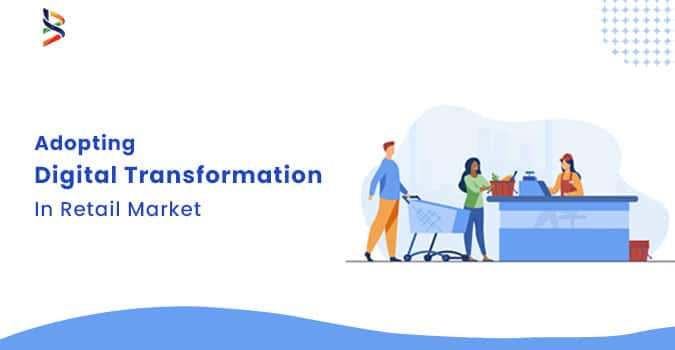
Best practices for adopting Digital Transformation in Retail Market
Best practices for adopting Digital
Transformation in Retail Market
Given below are the best practices for adopting Digital Transformation in the Retail Market:
1. Understand the Activity of the customers
One of the most critical factors that you should do if you want to execute a successful digital transformation in retail would be to understand where your customers are actively engaging fully. One should perform social engineering in the interest of the customer and must react according to the requirements and importance of the customer. This is a very significant practice as it helps in guiding towards the right path when it comes to solving out where you should be giving your time and resources.
2. Always focus on the Target Customer
Another significant factor that plays a vital role in implementing the digital transformation in retail is to figure out the way to how to best target your ideal customer and mainly focus on them throughout the entire experience. When you want to offer them what they want and understand what they need in the way they want, this typically focuses on incorporating the mobile strategies in your customer experience because nowadays customers generally use their mobile phones to shop for things. In the past time, the retail model was primarily dedicated to and focused on being product-driven. So now they need to transform,
and they must change to digitalization.
3. Operations
Enterprise automation
Automation of processes reduces the human effort in the organization so that retailers can reduce operational costs, process turnaround times, and manual mistakes. Operations that can be automated in the retail industry are as follows: ERP Activities that include billing, price changes, account payables, receivables Inventory/supply chain management Product categorization
4. Cashierless retail stores
Self-checkout systems have been the most interesting part of in-store retails from the customer perspective. It enables shorter lines and waiting times and reduces the labor cost for retailers. There is an emerging trend within self-checkout systems which is cashless/cardless retail stores. Amazon Go and Walmart are the pioneers in autonomous store technology and they are expanding their stores across the U.S.
5. Analytics
Machine learning-powered retail analytics With the increasing volume of data generated from organizations, performing analysis and uncovering insights become a necessity. Advanced technologies like machine learning fasten the process of data processing. Retailers gain actionable insights that may increase their revenue along with improving their business performance. AI models can be embedded in operational systems suggesting dynamic changes to diverse areas such as logistics, pricing, or layout. To
learn more about retail analytics, feel free to check our article.
Benefits of Digital Transformation in Retail Industry
Listed below are the various benefits of Digital Transformation in the Retail Industry:
1. Digital Marketing
Digital Transformation in Retail is changing the way in which companies nowadays reach out to their customer in the most proficient method to target specific customers’ profiles, and this also increases the client-side interaction with the company, which will benefit the product, service, and company.
2. Omnichannel retail
Digital Transformation in the Retail industry has a multichannel sales approach that offers a more distinct and personalized shopping experience to its customers.
3. Analytics
Big Data plays a vital role and is widely used in retail. As it gives insights into customer behavior as well as helps in predicting the trend, Big data forecast demands, optimizing pricing and business operations, and customizing your offer to be ahead of consumers and satisfy their needs and wants.
4. Cloud Services
Corporations compete in industries incorporated by cloud technologies in an attempt to adapt to rapidly changing technological trends. It enables companies to improve their operations to serve customers efficiently.
5. Artificial Intelligence
A significant Artificial Intelligence change is the evolution of stores without cashiers as Amazon Go has an entirely automated supermarket in Seattle. It erases the checkout lines and cashiers. Some Other Benefits are:-
#Voice activation
#Virtual Reality
#Augmented Reality
#Sensor Data
Evaluating the best practices?
We have identified three common best practices for digital transformation in the retail industry.
Faster digital experiences:
Slow page load times lead to unsatisfied customers. Web pages, content, and images should be managed for both performance and experience.
Agile approach:
Retailers need to experiment rapidly with new technologies and rapidly migrate their systems to established technologies to transform their businesses:
Shift to the cloud:
Most modern retailers shift their servers into the cloud to increase their focus on retail. Amazon does a lot more in this aspect. As a leader in cloud computing, Amazon powers other companies’ cloud efforts. Cloud enables retailers to flexibly scale while decreasing the cost of ownership.
AI transformation:
Digital transformation has been around since the 90s. When retailers focus on digital transformation, they should implement the latest advances which include the advances in AI. We’ve written extensively on advanced analytics use cases in retail and AI transformation.
Security focus:
Enterprise and customer data are the most valuable assets of retailers. If hackers exploit any security vulnerability, customers lose their trust in the organization. Retailers must invest in cybersecurity solutions. If you need consulting for your digital transformation plans, we’ve prepared or If you are looking for a digital transformation consulting company, CONNECT.
Potential of Model age digitalization
In the modern age of the Internet and smartphones, users are always connected online, even in real life.
When purchasing a product or eating out, it is natural to “search” and “compare with others” to decide on the purchase. Therefore, by fusing and making full use of online and offline, companies can consider “how to deliver high-quality information and convey value” and “how to build continuous relationships with customers” and provide services. It is required to reflect in. That’s all about Digital Transformation in Retail Industry


FEEL FREE TO DROP US A LINE.